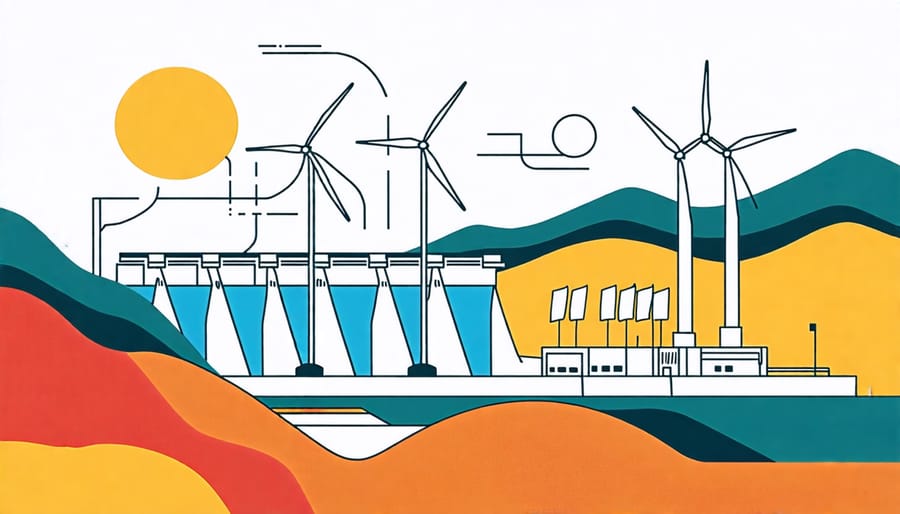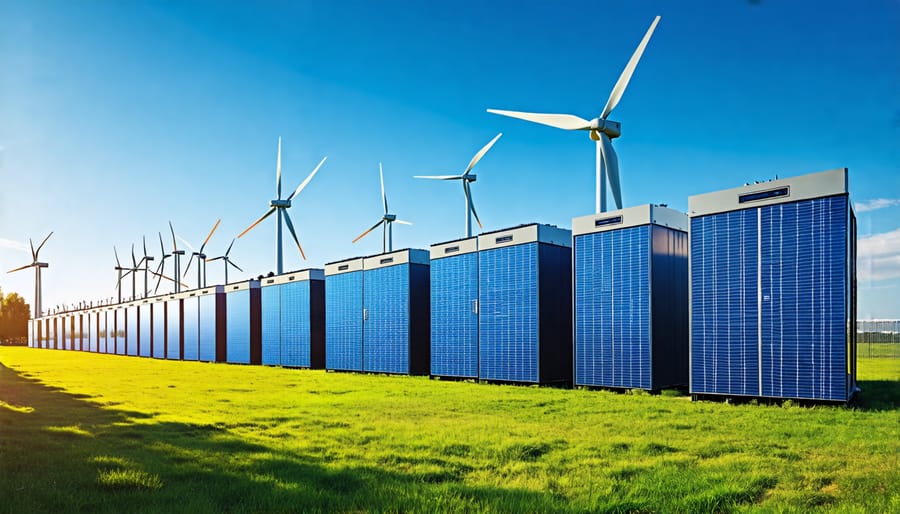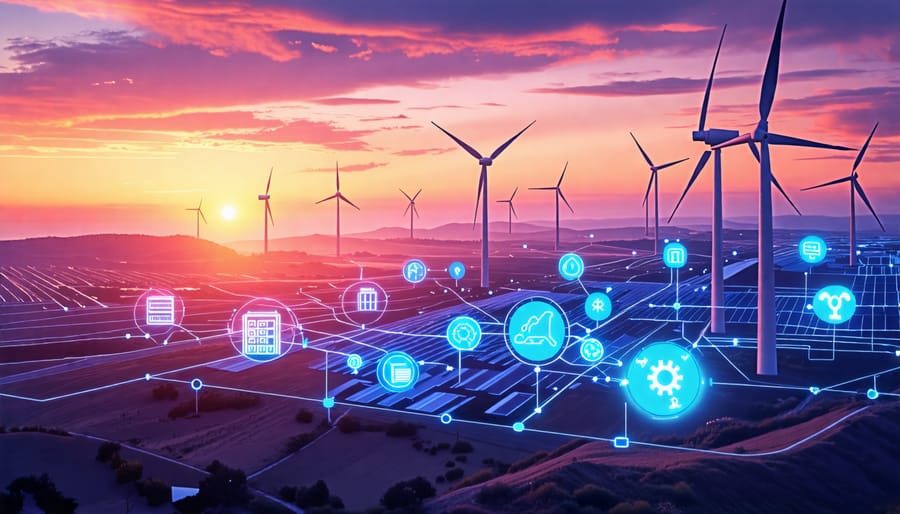Harness wind’s potential by combining wind turbines with energy storage solutions to stabilize output and align supply with demand. Develop a portfolio approach incorporating multiple storage technologies optimized for different timescales, from flywheels and batteries for short-term smoothing to compressed air and hydrogen for longer-term, seasonal shifting. Understand how wind power works and integrate storage at both the turbine and grid level to maximize flexibility and resilience. Accelerate investment in storage R&D and demonstration projects to drive down costs, validate reliability, and pave the way for widescale commercial deployment as part of the clean energy transition.
The Critical Role of Energy Storage
Balancing Supply and Demand
Energy storage plays a critical role in balancing the variable output of wind power with fluctuating electricity demand. Wind energy is intermittent, meaning that turbines generate power only when the wind is blowing. This variability can create challenges for grid operators who must constantly match supply with demand. By storing excess wind energy during periods of high production and releasing it when demand peaks or winds are calm, energy storage technologies help smooth out the intermittency of wind power.
This enables a greater integration of wind energy into the grid while maintaining reliability and stability. Storage solutions, such as batteries, pumped hydro, and compressed air, act as a buffer between wind farms and the grid, allowing for a more consistent and predictable flow of electricity. As the penetration of wind power continues to grow, energy storage will become increasingly important in facilitating the transition to a cleaner, more sustainable energy future.
Enhancing Grid Stability and Reliability
Energy storage plays a vital role in maintaining grid stability and reliability as wind power penetration increases. When wind speeds fluctuate, storage systems can quickly absorb or release energy to balance frequency and voltage, ensuring a steady power supply. By smoothing out the variable nature of wind, storage enhances overall grid resilience.
Advanced technologies like lithium-ion batteries and compressed air storage can respond rapidly to changes in wind output, providing essential ancillary services to the grid. These systems act as a buffer, storing excess energy during high winds and dispatching it when needed, thereby reducing the strain on conventional power plants and transmission infrastructure. As wind continues to grow, integrating storage will be key to creating a more flexible, reliable, and sustainable electric grid.
Current Energy Storage Technologies for Wind Power
Pumped Hydroelectric Storage
Pumped hydroelectric storage is the most established and widely used form of bulk energy storage for wind power. This technology involves pumping water uphill into a reservoir when excess wind energy is available, then releasing it downhill through turbines to generate electricity when needed. Pros include high storage capacity, long lifetime, and ability to store energy for extended periods. However, it requires specific geographical features and has high upfront costs. Successful examples include the Bath County Pumped Storage Station in Virginia, USA, which supports nearby wind farms, and the Cruachan Power Station in Scotland, providing backup for UK wind energy. Despite limitations, pumped hydro remains a proven solution for large-scale wind energy storage.

Battery Energy Storage Systems
The rapid growth and improving economics of lithium-ion and other battery technologies are driving the adoption of battery energy storage systems for wind power. Batteries can store excess energy generated during high wind periods and discharge it when demand is high or wind speeds are low. This helps smooth out the variable nature of wind energy and enables greater integration of wind power into the grid. Falling costs and increasing energy densities of lithium-ion batteries, in particular, have made large-scale battery storage more economically viable for wind farms. Other emerging battery chemistries, such as flow batteries and sodium-ion, also show promise for long-duration energy storage applications in the wind industry.
Compressed Air Energy Storage
Compressed Air Energy Storage (CAES) is a promising solution for storing wind-generated electricity during off-peak periods. In CAES systems, excess wind energy powers compressors to pressurize air into underground caverns or above-ground tanks. When electricity demand rises, the compressed air is released, heated, and expanded through turbines to generate power. CAES offers advantages such as large storage capacities, long lifetimes, and quick response times. The Huntorf plant in Germany, operational since 1978, showcases CAES’s ability to complement wind power. In the U.S., the Iowa Stored Energy Park aims to integrate CAES with a 100 MW wind farm, demonstrating the technology’s potential to enhance wind energy’s reliability and dispatchability.
Emerging Technologies
Emerging technologies hold promise for transforming wind energy storage. Flow batteries, which store energy in liquid electrolytes, offer high capacity and long lifetimes. Liquid air energy storage cools and compresses air into a liquid, releasing energy as it warms and expands. Power-to-gas converts excess electricity into hydrogen or methane for later use. While still developing, these innovative solutions could provide the large-scale, long-duration storage wind power needs to fully integrate with the grid. As research advances, expect to see pilot projects demonstrating the potential of these cutting-edge technologies to enable a more sustainable and reliable wind-powered future.

Integrated Wind-Storage Projects: Success Stories
Here are two notable examples of wind-plus-storage projects that showcase the potential of combining wind power with energy storage:
The Hornsdale Power Reserve in South Australia, launched in 2017, is the world’s first grid-scale battery integrated with a wind farm. With a capacity of 100 MW/129 MWh, the lithium-ion battery system is connected to the 315 MW Hornsdale Wind Farm. Developed by Tesla and Neoen, the project has demonstrated the ability to provide grid stabilization services, reduce power outages, and lower electricity costs for consumers. The battery’s rapid response capability has proven invaluable in maintaining grid frequency and preventing blackouts during critical events.
Another groundbreaking project is the Batwind offshore wind-plus-storage system in Scotland, commissioned in 2018. This pilot project, a collaboration between Equinor and Masdar, integrates a 1 MW/1.3 MWh lithium-ion battery with the 30 MW Hywind Scotland floating offshore wind farm. The battery system, located onshore, helps to mitigate the variability of wind power by storing excess energy during high wind periods and releasing it during low wind periods. This demonstrator project aims to optimize the output of offshore wind farms and pave the way for larger-scale integration of wind power and energy storage.
These pioneering projects highlight the synergies between wind power and energy storage, offering a glimpse into a future where renewable energy can be harnessed more efficiently and reliably. As the costs of both wind power and storage technologies continue to decline, more wind-plus-storage projects are expected to emerge worldwide, driving the transition towards a clean energy future.
Policy and Market Drivers
Supportive Policies and Incentives
Supportive policies and incentives are crucial for driving the adoption of energy storage in the wind power sector. In the United States, the Investment Tax Credit (ITC) has been extended to include energy storage, providing a 30% credit for storage projects that are charged by renewable energy at least 75% of the time. This is a significant boost for wind-plus-storage projects. Additionally, several states have implemented storage mandates, with California leading the way in requiring utilities to procure large amounts of storage capacity. Other key markets like New York, Massachusetts, and Oregon have also set ambitious storage targets. Governments are offering grants, loans, and other financial incentives to spur storage development. These favorable policies, combined with declining technology costs and increasing demand for grid flexibility, are creating a supportive environment for the growth of energy storage in the wind industry.
Decreasing Technology Costs
The declining costs and improving performance of energy storage technologies are major factors driving their increased uptake in the wind power sector. Over the past decade, the price of lithium-ion batteries, a popular choice for wind energy storage, has fallen by nearly 90%. This cost reduction, coupled with advancements in battery capacity and longevity, is making storage an increasingly viable solution for addressing the intermittency challenges of wind power.
Moreover, the emergence of innovative storage technologies, such as flow batteries and compressed air energy storage, is further expanding the options available to wind farm operators. As these technologies mature and scale, they are expected to become even more cost-competitive, further accelerating the adoption of energy storage in the wind industry. This trend is not only enhancing the reliability and dispatchability of wind power but also contributing to the overall affordability and sustainability of renewable energy.
The Future of Wind Energy Storage
Cutting-edge storage solutions like flow batteries, compressed air storage, and gravity-based systems are poised to revolutionize the wind energy sector in the coming years. Experts predict significant advancements in energy density, efficiency, and cost-effectiveness. Long-duration storage will be crucial for overcoming intermittency challenges and enabling wind power to provide baseload electricity. The integration of AI and IoT technologies will optimize storage operations and grid integration. Increased investment and supportive policies will drive rapid adoption. As future innovations in wind power unfold, advanced storage will play a pivotal role in accelerating the transition to a clean, wind-powered future.





